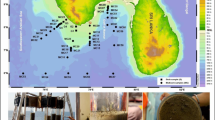Abstract
A total of 38 219 specimens representing 63 species of marine isopods (Crustacea) from deep and shallow Arctic waters were studied in a search for epizoic foraminifers (Protozoa). Foraminifers occurred on 21 species, and their frequency was generally low. A total of 290 foraminifer individuals were found, of which 289 belonged to Cibicides wuellerstorfi, C. refulgens and Cibicides spp. (juveniles) (Cibicidae), while only a single individual belonged to Cornuspira sp. (Cornuspiridae). The foraminifers were most frequent on species of the families Munnidae, Ischnomesidae (suborder Asellota) and on Gnathia stygia (suborder Gnathiidea), but were totally absent from the asellote families Janiridae, Haploniscidae, Nannoniscidae and from the suborder Epicaridea. The foraminifers were mainly located on the legs (Munna acanthifera), the anterior part of the body (Haplomesus quadrispinosus, heteromesus frigidus), or on the head (G. stygia adults). The epizoic foraminifers occur mainly on epibenthic isopods, which do not or only rarely clean themselves. The foraminifers are known to prefer elevated substrata, and in this the habitat of the isopods and the foraminifers coincide. The size of individual isopods was not related to the presence or absence of foraminifers.
Similar content being viewed by others
References
Alexander, S. P., DeLaca, T. E. (1987). Feeding adaptations of the foraminiferan Cibicides refulgens living epizoically and parasitically on the antarctic scallop Adamussium colbecki. Biol. Bull. mar. biol. Lab., Woods Hole 173:136–159
George, R. Y., Higgins, R. P. (1979). Eutrophic hadal benthic community in the Puerto Rico Trench. Ambio spec. Rep. 6: 51–58
Gooday, A. (1984). Records of the deep-sea rhizopod tests inhabited by metazoans in the north-east Atlantic. Sarsia 69:45–53
Haward, N. J. B., Haynes, J. R. (1976). Chlamys opercularis (Linnaeus) as a mobile substrate for foraminifera. J. foraml Res. 6: 30–38
Hessler, R. R., Strömberg, J.-O. (1989). Behaviour of janiroidean isopods (Asellota), with special reference to deep-sea genera. Sarsia 74:145–159
Klitgaard, A. (1991). Gnathia abyssorum (G. O. Sars, 1872) (Crustacea, Isopoda) associated with sponges. Sarsia 76:33–39
Levin, L. A., Childers, S. E., Smith, C. R. (1991) Epibenthic, agglutinating foraminiferans in the Santa Catalina Basin and their response to disturbance. Deep-Sea Res. 38:465–483
Lutze, G. F., Thiel, H. (1989). Epibenthic foraminifera from elevated microhabitats: Cibicidoides wuellerstorfi and Planulina ariminensis. J. foraml Res. 19:153–158
Mackensen, A., Sejrup, H. P., Jansen, E. (1984). The distribution of benthic foraminifera on the continental slope and rise off southwest Norway. Mar. Micropaleont. 9:275–306
Moore, P. G. (1985). Cibicides lobatulus (Protozoa: Foraminifera) epizoic on Astacilla longicornis (Crustacea: Isopoda) in the North Sea. J. nat. Hist. 19:129–133
Naylor, E. (1972). British marine isopods. Synopses Br. Fauna (New Ser.) 3:1–86
Nyholm, K. G. (1961). Morphogenesis and biology of the foraminifer Cibicides lobatulus. Zool. Bidr. Upps. 33:157–196
Rothlisberg, P. C., Pearcy, W. G. (1976). An epibenthic sampler used to study the ontogeny of vertical migration of Pandalus jordani (Decapoda, Caridea). Fish. Bull. U.S. 74:994–997
Smaldon, G. (1974). A note on the epizoites of porcelain crabs (Decapoda, Anomura). Crustaceana 27:314–315
Svavarsson, J. (1988a). Bathyal and abyssal asellota (Crustacea, Isopoda) from the Norwegian, Greenland, and North Polar Seas. Sarsia 73:83–106
Svavarsson, J. (1988b). Desmosomatidae (Isopoda, Asellota) from bathyal and abyssal depths in the Norwegian, Greenland and North Polar Seas. Sarsia 73:1–32
Thistle, D., Wilson, G. D. F. (1987). A hydrodynamically modified, abyssal isopod fauna. Deep-Sea Res. 34:73–87
Upton, N. P. D. (1987). Asynchronous male and female life cycles in the sexually dimorphic, harem forming isopod, Paragnathia formica Hesse (Crustacea: Isopoda). J. Zool. 212:677–690
Wolff, T. (1979). Macrofaunal utilization of plant remains in the deep sea. Sarsia 64:117–136
Author information
Authors and Affiliations
Additional information
Communicated by J. Mauchline, Oban
Rights and permissions
About this article
Cite this article
Svavarsson, J., Davíðsdóttir, B. Foraminiferan (Protozoa) epizoites on Arctic isopods (Crustacea) as indicators of isopod behaviour?. Marine Biology 118, 239–246 (1994). https://doi.org/10.1007/BF00349790
Received:
Accepted:
Issue Date:
DOI: https://doi.org/10.1007/BF00349790




